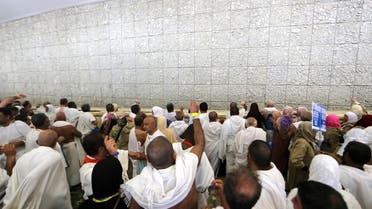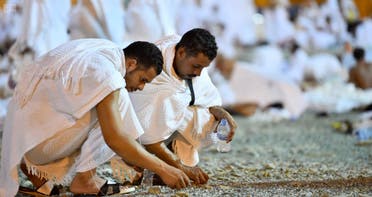𝐄𝐗𝐏𝐋𝐀𝐈𝐍𝐄𝐑: 𝐇𝐢𝐬𝐭𝐨𝐫𝐢𝐜, 𝐬𝐲𝐦𝐛𝐨𝐥𝐢𝐜 𝐬𝐢𝐠𝐧𝐢𝐟𝐢𝐜𝐚𝐧𝐜𝐞 𝐛𝐞𝐡𝐢𝐧𝐝 ‘𝐬𝐭𝐨𝐧𝐢𝐧𝐠 𝐭𝐡𝐞 𝐝𝐞𝐯𝐢𝐥’ 𝐚𝐭 𝐇𝐚𝐣𝐣/𝐏𝐢𝐥𝐠𝐫𝐢𝐦𝐚𝐠𝐞 𝐢𝐧 𝐌𝐞𝐜𝐜𝐚
Mohamad Mostafa Nassar
Twitter:@NassarMohamadMR

𝐓𝐡𝐞 𝐬𝐭𝐨𝐧𝐢𝐧𝐠 𝐨𝐟 𝐭𝐡𝐞 𝐝𝐞𝐯𝐢𝐥 𝐚𝐭 𝐭𝐡𝐞 𝐈𝐬𝐥𝐚𝐦𝐢𝐜 𝐩𝐢𝐥𝐠𝐫𝐢𝐦𝐚𝐠𝐞 𝐫𝐞𝐟𝐞𝐫𝐬 𝐭𝐨 𝐏𝐫𝐨𝐩𝐡𝐞𝐭 𝐀𝐛𝐫𝐚𝐡𝐚𝐦’𝐬 𝐚𝐭𝐭𝐞𝐦𝐩𝐭 𝐭𝐨 𝐫𝐞𝐩𝐞𝐥 𝐭𝐡𝐞 𝐝𝐞𝐯𝐢𝐥 𝐟𝐫𝐨𝐦 𝐬𝐥𝐚𝐮𝐠𝐡𝐭𝐞𝐫𝐢𝐧𝐠 𝐡𝐢𝐬 𝐬𝐨𝐧 𝐈𝐬𝐡𝐦𝐚𝐞𝐥. 𝐀𝐛𝐫𝐚𝐡𝐚𝐦 𝐭𝐡𝐫𝐞𝐰 𝐬𝐞𝐯𝐞𝐧 𝐬𝐭𝐨𝐧𝐞𝐬 𝐢𝐧 𝐭𝐡𝐞 𝐬𝐚𝐦𝐞 𝐩𝐥𝐚𝐜𝐞 𝐰𝐡𝐞𝐫𝐞 𝐭𝐡𝐞 𝐩𝐢𝐥𝐠𝐫𝐢𝐦𝐬 𝐝𝐨 𝐧𝐨𝐰𝐚𝐝𝐚𝐲𝐬.
𝐓𝐡𝐞 𝐫𝐢𝐭𝐞 𝐛𝐞𝐜𝐚𝐦𝐞 𝐚 𝐇𝐚𝐣𝐣 𝐫𝐢𝐭𝐮𝐚𝐥 𝐝𝐮𝐞 𝐭𝐨 𝐏𝐫𝐨𝐩𝐡𝐞𝐭 𝐌𝐨𝐡𝐚𝐦𝐦𝐞𝐝 𝐰𝐡𝐨 𝐰𝐡𝐞𝐧 𝐡𝐞 𝐩𝐞𝐫𝐟𝐨𝐫𝐦𝐞𝐝 𝐭𝐡𝐞 𝐟𝐚𝐫𝐞𝐰𝐞𝐥𝐥 𝐩𝐢𝐥𝐠𝐫𝐢𝐦𝐚𝐠𝐞, 𝐡𝐞 𝐭𝐡𝐫𝐞𝐰 𝐬𝐞𝐯𝐞𝐧 𝐬𝐭𝐨𝐧𝐞𝐬 𝐭𝐡𝐞𝐫𝐞 𝐚𝐟𝐭𝐞𝐫 𝐭𝐡𝐞 𝐧𝐨𝐨𝐧 𝐩𝐫𝐚𝐲𝐞𝐫𝐬. 𝐖𝐡𝐢𝐥𝐞 𝐩𝐞𝐫𝐟𝐨𝐫𝐦𝐢𝐧𝐠 𝐭𝐡𝐞 𝐫𝐢𝐭𝐞𝐬, 𝐡𝐞 𝐬𝐚𝐢𝐝: “𝐓𝐚𝐤𝐞 𝐲𝐨𝐮𝐫 𝐫𝐢𝐭𝐞𝐬 𝐟𝐫𝐨𝐦 𝐦𝐞.”
𝐃𝐮𝐫𝐢𝐧𝐠 𝐭𝐡𝐞 𝐫𝐢𝐭𝐮𝐚𝐥, 𝐌𝐮𝐬𝐥𝐢𝐦 𝐩𝐢𝐥𝐠𝐫𝐢𝐦𝐬 𝐭𝐡𝐫𝐨𝐰 𝐩𝐞𝐛𝐛𝐥𝐞𝐬 𝐚𝐭 𝐭𝐡𝐫𝐞𝐞 𝐰𝐚𝐥𝐥𝐬.
𝐓𝐡𝐞 𝐩𝐞𝐛𝐛𝐥𝐞𝐬 𝐮𝐬𝐞𝐝 𝐢𝐧 𝐭𝐡𝐞 𝐬𝐭𝐨𝐧𝐢𝐧𝐠 𝐚𝐫𝐞 𝐭𝐫𝐚𝐝𝐢𝐭𝐢𝐨𝐧𝐚𝐥𝐥𝐲 𝐠𝐚𝐭𝐡𝐞𝐫𝐞𝐝 𝐚𝐭 𝐌𝐮𝐳𝐝𝐚𝐥𝐢𝐟𝐚𝐡, 𝐚 𝐩𝐥𝐚𝐢𝐧 𝐬𝐨𝐮𝐭𝐡𝐞𝐚𝐬𝐭 𝐨𝐟 𝐌𝐢𝐧𝐚, 𝐨𝐧 𝐭𝐡𝐞 𝐧𝐢𝐠𝐡𝐭 𝐛𝐞𝐟𝐨𝐫𝐞 𝐭𝐡𝐞 𝐟𝐢𝐫𝐬𝐭 𝐭𝐡𝐫𝐨𝐰𝐢𝐧𝐠.
𝐎𝐧 𝐄𝐢𝐝 𝐚𝐥-𝐀𝐝𝐡𝐚 (𝐭𝐡𝐞 𝟏𝟎𝐭𝐡 𝐝𝐚𝐲 𝐨𝐟 𝐭𝐡𝐞 𝐦𝐨𝐧𝐭𝐡 𝐨𝐟 𝐃𝐡𝐮 𝐚𝐥-𝐇𝐢𝐣𝐣𝐚𝐡), 𝐩𝐢𝐥𝐠𝐫𝐢𝐦𝐬 𝐦𝐮𝐬𝐭 𝐬𝐭𝐫𝐢𝐤𝐞 𝐨𝐧𝐥𝐲 𝐨𝐧𝐞 𝐨𝐟 𝐭𝐡𝐞 𝐭𝐡𝐫𝐞𝐞 𝐣𝐚𝐦𝐫𝐚𝐚𝐭; 𝐬𝐩𝐞𝐜𝐢𝐟𝐢𝐜𝐚𝐥𝐥𝐲, 𝐭𝐡𝐞 𝐥𝐚𝐫𝐠𝐞𝐫 𝐨𝐧𝐞; 𝐰𝐢𝐭𝐡 𝐬𝐞𝐯𝐞𝐧 𝐩𝐞𝐛𝐛𝐥𝐞𝐬.

𝐓𝐡𝐞𝐫𝐞 𝐚𝐫𝐞 𝐟𝐨𝐮𝐫 𝐝𝐚𝐲𝐬 𝐨𝐟 𝐬𝐭𝐨𝐧𝐢𝐧𝐠 𝐭𝐡𝐞 𝐝𝐞𝐯𝐢𝐥. 𝐓𝐡𝐞 𝐟𝐢𝐫𝐬𝐭 𝐝𝐚𝐲 𝐭𝐡𝐞𝐲 𝐬𝐭𝐨𝐧𝐞 𝐭𝐡𝐞 𝐝𝐞𝐯𝐢𝐥 𝐢𝐬 𝐨𝐧 𝐭𝐡𝐞 𝐟𝐢𝐫𝐬𝐭 𝐝𝐚𝐲 𝐨𝐟 𝐄𝐢𝐝 𝐚𝐥-𝐀𝐝𝐡𝐚. 𝐓𝐡𝐞𝐧 𝐟𝐨𝐫 𝐭𝐡𝐞 𝐧𝐞𝐱𝐭 𝐭𝐡𝐫𝐞𝐞 𝐝𝐚𝐲𝐬, 𝐭𝐡𝐞𝐲 𝐬𝐲𝐦𝐛𝐨𝐥𝐢𝐜𝐚𝐥𝐥𝐲 𝐬𝐭𝐨𝐧𝐞 𝐭𝐡𝐞 𝐝𝐞𝐯𝐢𝐥 𝐚𝐠𝐚𝐢𝐧.

𝐓𝐡𝐞 𝐫𝐢𝐭𝐮𝐚𝐥 𝐨𝐟 𝐬𝐭𝐨𝐧𝐢𝐧𝐠 𝐭𝐡𝐞 𝐝𝐞𝐯𝐢𝐥 𝐡𝐚𝐬 𝐨𝐯𝐞𝐫 𝐭𝐡𝐞 𝐝𝐞𝐜𝐚𝐝𝐞𝐬 𝐰𝐢𝐭𝐧𝐞𝐬𝐬𝐞𝐝 𝐬𝐨𝐦𝐞 𝐜𝐡𝐚𝐧𝐠𝐞𝐬 𝐭𝐨 𝐟𝐚𝐜𝐢𝐥𝐢𝐭𝐚𝐭𝐞 𝐢𝐭𝐬 𝐩𝐞𝐫𝐟𝐨𝐫𝐦𝐚𝐧𝐜𝐞. 𝐓𝐡𝐞 𝐉𝐚𝐦𝐚𝐫𝐚𝐚𝐭 𝐁𝐫𝐢𝐝𝐠𝐞 𝐢𝐬 𝐥𝐢𝐧𝐤𝐞𝐝 𝐭𝐨 𝐭𝐡𝐞 𝐩𝐢𝐥𝐠𝐫𝐢𝐦𝐬’ 𝐜𝐚𝐦𝐩 𝐨𝐧 𝐭𝐡𝐞 𝐟𝐨𝐨𝐭𝐡𝐢𝐥𝐥𝐬 𝐨𝐟 𝐭𝐡𝐞 𝐌𝐢𝐧𝐚 𝐌𝐨𝐮𝐧𝐭𝐚𝐢𝐧, 𝐚𝐧𝐝 𝐢𝐭 𝐡𝐚𝐬 𝟏𝟏 𝐞𝐧𝐭𝐫𝐚𝐧𝐜𝐞𝐬 𝐚𝐧𝐝 𝟏𝟐 𝐞𝐱𝐢𝐭𝐬 𝐭𝐨 𝐫𝐞𝐝𝐮𝐜𝐞 𝐜𝐫𝐨𝐰𝐝𝐞𝐝 𝐚𝐫𝐞𝐚𝐬. 𝐈𝐭𝐬 𝐟𝐨𝐮𝐧𝐝𝐚𝐭𝐢𝐨𝐧 𝐢𝐬 𝐬𝐮𝐛𝐣𝐞𝐜𝐭 𝐭𝐨 𝐞𝐱𝐩𝐚𝐧𝐬𝐢𝐨𝐧 𝐭𝐨 𝟏𝟐 𝐟𝐥𝐨𝐨𝐫𝐬.

𝐖𝐡𝐢𝐥𝐞 𝐩𝐢𝐥𝐠𝐫𝐢𝐦𝐬 𝐩𝐞𝐫𝐟𝐨𝐫𝐦 𝐭𝐡𝐞 𝐫𝐢𝐭𝐮𝐚𝐥, 𝐬𝐮𝐫𝐯𝐞𝐢𝐥𝐥𝐚𝐧𝐜𝐞 𝐜𝐚𝐦𝐞𝐫𝐚𝐬 𝐦𝐨𝐧𝐢𝐭𝐨𝐫 𝐭𝐡𝐞 𝐩𝐢𝐥𝐠𝐫𝐢𝐦𝐬’ 𝐟𝐥𝐨𝐰 𝐭𝐨 𝐡𝐞𝐥𝐩 𝐭𝐡𝐞 𝐨𝐫𝐠𝐚𝐧𝐢𝐳𝐞𝐫𝐬 𝐨𝐧 𝐭𝐡𝐞 𝐠𝐫𝐨𝐮𝐧𝐝, 𝐝𝐞𝐭𝐞𝐜𝐭 𝐡𝐞𝐚𝐥𝐭𝐡 𝐢𝐬𝐬𝐮𝐞𝐬 𝐚𝐧𝐝 𝐩𝐫𝐨𝐯𝐢𝐝𝐞 𝐦𝐞𝐝𝐢𝐜𝐚𝐥 𝐬𝐞𝐫𝐯𝐢𝐜𝐞𝐬. 𝐈𝐧 𝐨𝐫𝐝𝐞𝐫 𝐭𝐨 𝐝𝐞𝐚𝐥 𝐰𝐢𝐭𝐡 𝐞𝐦𝐞𝐫𝐠𝐞𝐧𝐜𝐲 𝐜𝐚𝐬𝐞𝐬, 𝐭𝐡𝐞 𝐛𝐫𝐢𝐝𝐠𝐞 𝐰𝐚𝐬 𝐞𝐪𝐮𝐢𝐩𝐩𝐞𝐝 𝐰𝐢𝐭𝐡 𝐚 𝐡𝐞𝐥𝐢𝐜𝐨𝐩𝐭𝐞𝐫 𝐥𝐚𝐧𝐝𝐢𝐧𝐠 𝐩𝐚𝐝. 𝐃𝐮𝐫𝐢𝐧𝐠 𝐡𝐨𝐭 𝐝𝐚𝐲𝐬, 𝐭𝐡𝐞 𝐛𝐫𝐢𝐝𝐠𝐞’𝐬 𝐜𝐨𝐨𝐥𝐢𝐧𝐠 𝐬𝐲𝐬𝐭𝐞𝐦 𝐨𝐩𝐞𝐫𝐚𝐭𝐞𝐬 𝐯𝐢𝐚 𝐝𝐞𝐬𝐞𝐫𝐭 𝐚𝐢𝐫 𝐜𝐨𝐧𝐝𝐢𝐭𝐢𝐨𝐧𝐞𝐫𝐬 𝐚𝐧𝐝 𝐜𝐡𝐚𝐧𝐧𝐞𝐥𝐬 𝐭𝐡𝐚𝐭 𝐬𝐩𝐫𝐚𝐲 𝐰𝐚𝐭𝐞𝐫 𝐨𝐧 𝐩𝐢𝐥𝐠𝐫𝐢𝐦𝐬.

𝐒𝐨𝐮𝐫𝐜𝐞: 𝐄𝐧𝐠𝐥𝐢𝐬𝐡 𝐀𝐥𝐚𝐫𝐚𝐛𝐢𝐲𝐚
𝐀𝐥𝐥𝐚𝐡 𝐊𝐧𝐨𝐰𝐬 𝐁𝐞𝐬𝐭.
𝐑𝐞𝐟𝐞𝐫𝐞𝐧𝐜𝐞𝐬:
The story behind the stoning of Satan during Hajj/Pilgrimage